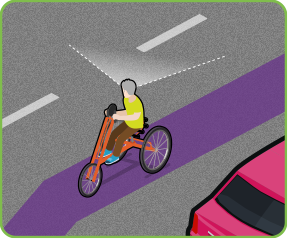3.7. Practising routines when cycling
Routine-based cycling allows you to apply the four key skills to any situation, by using short sequences of actions that are easy to remember. This can be helpful when riding in all environments where cycling is permitted. It is important to remember however that independent decision making still applies, and each step of the routine is not automatic, but a conscious choice.
A routine will always start with observation, and you must always be thinking about what comes next in your journey. Using routines does not mean doing the same thing every time. It requires you to be flexible in how you carry out specific manoeuvres.
Below are examples of short routines as listed in the National Standard. These are very simplified versions of what you will do and must be combined with independent decision making. Remember that no junction or set of circumstances is ever the same. You will always need to adapt to your surroundings – for example, the number of road users or the speed at which they are moving.
How to change position using a routine:




- Look behind for following vehicles.
- Communicate intentions to other road users ahead or behind if necessary.
- Change position when there is time and space to do so.
How to negotiate junctions using a routine:




- Look behind for following vehicles.
- Communicate intentions to other road users ahead or behind if necessary.
- Choose a suitable riding position.
- Prioritise who goes first at the junction.
How to use a routine when communicating intentions:




- Look behind for following vehicles.
- Communicate intentions to other road users ahead or behind if necessary.
- Check they have responded to your signal.
- Perform the manoeuvre.
*This routine differs from the others in that it covers a much longer sequence of choices. When negotiating a junction all of the key skills will be thought about and acted on more than once, however it can help new riders to remember to think about each of them by presenting a short example like this one from the National Standard
